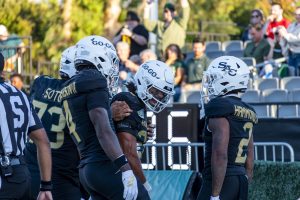Traces’ Romanian art gallery boasts a country’s culture and political history
October 2, 2008
When someone talks about ‘a trace’ of something, he or she usually means something that was left behind in the past – traces of paint from an old wall memorial, traces of a building foundation, traces of an ancient civilization – the list goes on and on. Yet, such a stereotype could not be used to describe “Traces: Contemporary Romanian Art,” the exhibit presented in the Else gallery.
The show features a collection of Romanian art crafted since the fall of communist dictator Nicolae Ceausescu in 1989, after reigning for nearly 25 years.
But why name it “Traces”?
“It has to do with the fact that the show is not showing everything there is on Romanian art, but sort of surfacing the traces of it,” Elaine O’Brien said. O’Brien is an associate professor in the Art History department, and co-curator of the exhibit.
The inspiration for “Traces” began 15 years ago when O’Brien’s friend, Ann Albritton, a professor in the Ringling College of Art and Design in Sarasota, Fla., flew to Bucharest, Romania to teach modern and contemporary art history at the Grigorescu Academy of Art (now known as the National University of Art). It was there that Albritton experienced firsthand a change in the art that was created in the post-Ceausescu years.
When Albritton returned to Romania in the fall of 2006 during her sabbatical, she suggested to two former students, Mirela Ivanciu and Carmen Iovitu, that the three of them curate an exhibition of Romanian contemporary art with O’Brien. O’Brien had already seen the budding of Romania’s post-Ceauseseu art when she visited Albritton in 1995. Soon the idea spread to have the exhibit available, not only to Romania, but to have the exhibit travel to other parts of the world.
All the pieces brought over are those that could travel from Romania in one leather suitcase and two package tubes, said co-curator Carmen Iovitu, and since then has been seen by viewers in France, Florida, and California. What it lacks in size, however, it makes up in sheer diversity. What is perhaps most notable about the art is its mix of the past and present, of tradition and innovation.
Walking into the gallery, this eclecticism hits you almost immediately. The video “Time to Time” plays from a projector onto the far corner of the gallery, documenting men and young boys dressed as bears while performing a traditional dance that dates, according to the Traces program, to the pre-Christian era.
In the opposite corner, a series of embroidered placements shows couples stitched under romantic lines like, “Waiting in the parking (lot) to give you sweet kisses” or even the even more saucy, “Your tongue makes me shiver from night until dawn.”
Closer to the entrance is a bust of Joseph Stalin, painted in array of bright, unmatched colors. Suzana Dan, the artist who bought the bust and gave it a “Bollywood-style” makeover, said that this was the kind of statue that would sit on the commander’s desk. Dan and Ana Banica, two of the artists whose work is presented in the exhibit, visited the school on Sept. 8 for an artists’ panel with co-curator, Carmen Iovita.
“I really enjoyed the show. I like it a lot. There were a few pieces I wasn’t really sure about and didn’t really respond to, but they were still done well,” Jessica Lindeman, an art major who attended the artists’ panel said. Lindeman later said that she particularly enjoyed Dan’s work.
“I think (the students) will discover the way we react in front of unhappy aspects of life. But there are different responses. I’m responsible for the funny parts, but people have different responses that are still really well done,” Dan said.
These different responses include the pair of photographs that features the outside of an abandoned home in the mist of a winter day or the four-inch portraits sketched onto fabric pillows. The artist of these “Pillow Portraits,” Lila Passima, wrote in the exhibit’s program that the drawings show people who have been unkind to her.
The screening of 2007’s “California Dreamin'” on Thursday, Sept. 11 showed another type of art as well. Set against the backdrop of the 1999 NATO bombing of Yugoslavia, the film tells the story of a group of American soldiers who arrive in a small Romanian village of C?plni?a and the whirlwind they create during their stay among the inhabitants. One of these is Doiraru, the chief of the train station who routinely steals goods from the trains that pass by, and whose non-English speaking daughter, Monica, develops a crush on one of the soldiers.
“It’s fiction but it’s got some fake documentary elements. It’s funny but kind of in an Eastern-European, dark way,” O’Brien said.
In the end, the gallery gives students chance to experience a culture different from their own in its most creative form. O’Brien said that’s what makes the collection stand out.
“I guess what’s special about Romanian art is it shows their own history, their own location, their geography, their traditions.”
The exhibition is free to the public, and is in the Else Gallery of Kadema Hall. Gallery hours are noon to 4:30 p.m., and runs through Friday.
Kyrie Eberhart can be reached at [email protected]
























































































































